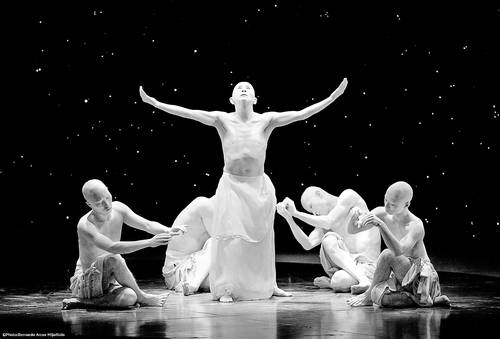Master Ushio Amagatsu, the most important figure in butoh dance after its founders, Tatsumi Hijikata and Kazuo Ohno, died on March 25 at the age of 74, as announced yesterday, due to a heart attack, despite having survived to pharyngeal cancer that was diagnosed seven years ago. Almost four decades ago he founded the Sankai Juku company, based at the Theater de la Ville in Paris. The French government recognized him with the Order of Knight of Arts and Letters of France. He is one of the great creators of universal art.
In several of the interviews he gave to The Day, He defined the principles of art that he developed for decades and achieved profound changes within the viewers:
–In your work there is an instant mind-body connection. How do you ascend to the third element, the spirit?
–It is a relationship between the interior and exterior of the body, where a certain environment, a certain environmental condition, is established. Spirit can be represented as feelings: it can be kind, sometimes very energetic, productive or in a searching attitude. These constant changes give rise to the relationship between the outside and inside of the body. It is then, in my works, that the dancers put both time and space in tension through concentration.
–When one observes his choreographies, one receives a storm of emotional impacts and concepts. From among that cluster, let’s highlight three: metaphor, ontology, metaphysics. How do you reflect these concepts towards the stage and the seats?
–For me, metaphor is something similar to mythology. The starting point for each myth may be different in each country, region or culture, but in general terms they are very similar. All myths from all cultures are very similar. I can say that although there are no agreed rules between human beings, their imaginary world will always be the same. It is a universality. Metaphor is, consequently, a universal phenomenon.
Regarding the metaphysical, Ushio Amagatsu explained, When I conceive a choreography and every time I perform it on stage, I always think about the metaphysical, because there is a basic principle that even scientists have already proven: the metamorphosis of a fetus in the womb is a metaphysics that all living beings have experienced over thousands of years. When the fertilized egg begins to separate into different cells, it takes the shape of a fish, and then takes the shape of an axolotl and arrives on Earth as a mammal. Everything the world has experienced for thousands of years, we do it for nine months in the womb. Being aware of this is knowing that our body is the frontispiece of universal history of thousands and thousands of years.
.
At the head of his company Sankai Juku, Ushio Amagatsu moved, shook, and left a deep impact on the spectators who attended each and every one of his numerous visits to Mexico.
In his work Tobari, for example, it brings into life an inexhaustible flow. He breaks the space-time vectors, he, at the head of a chorus of seven dancers, all naked, dressed only in loincloths or gauze or tulle or tunics and white powder and without any hair on their bodies. Their faces in ecstasy, their infinitesimal movements, slow of all slowness, open dimensional portals on the also bare stage, barely populated by eight gigantic little men, eight tiny titans under a still torrent of stars nailed on a vertical cyclorama.
The dance of Ushio Amagatsu is not made up of dance steps, but of mudras, mantras, mandalas and magic.
Zen concentration, the nirvanic ecstasy of the bodies, turns the work into a 90-minute collective meditation of conscious attention. In the midst of silence.
In his work Hibiki (Resonance of Faraway Places), Amagatsu takes a modern reading of Kabuki, Noh and Butoh to its ultimate consequences. Regarding his works, specialized critics have never managed to define it. The terms with which one could only approach: hallucinatory, hypnotic, fascinating, brutal, beauty in its purest form.
The minimalist movements of the master Amagatsu and his dancers show on stage the disappearance of the rules of physics and the appearance of the forces of nature. A feeling of infinity washes over us. It is the glorious roar of bodies, turned into light.
Among many resonances from distant places, a crackling sound is heard that is born from silence: tons of sound in a scream that never sounds, it is only drawn on the white faces of the dancers and their Zen master. All of them trace with their bodies a thousand metaphors in a pond over which the thunderous roar of a note of falling water resounds.
